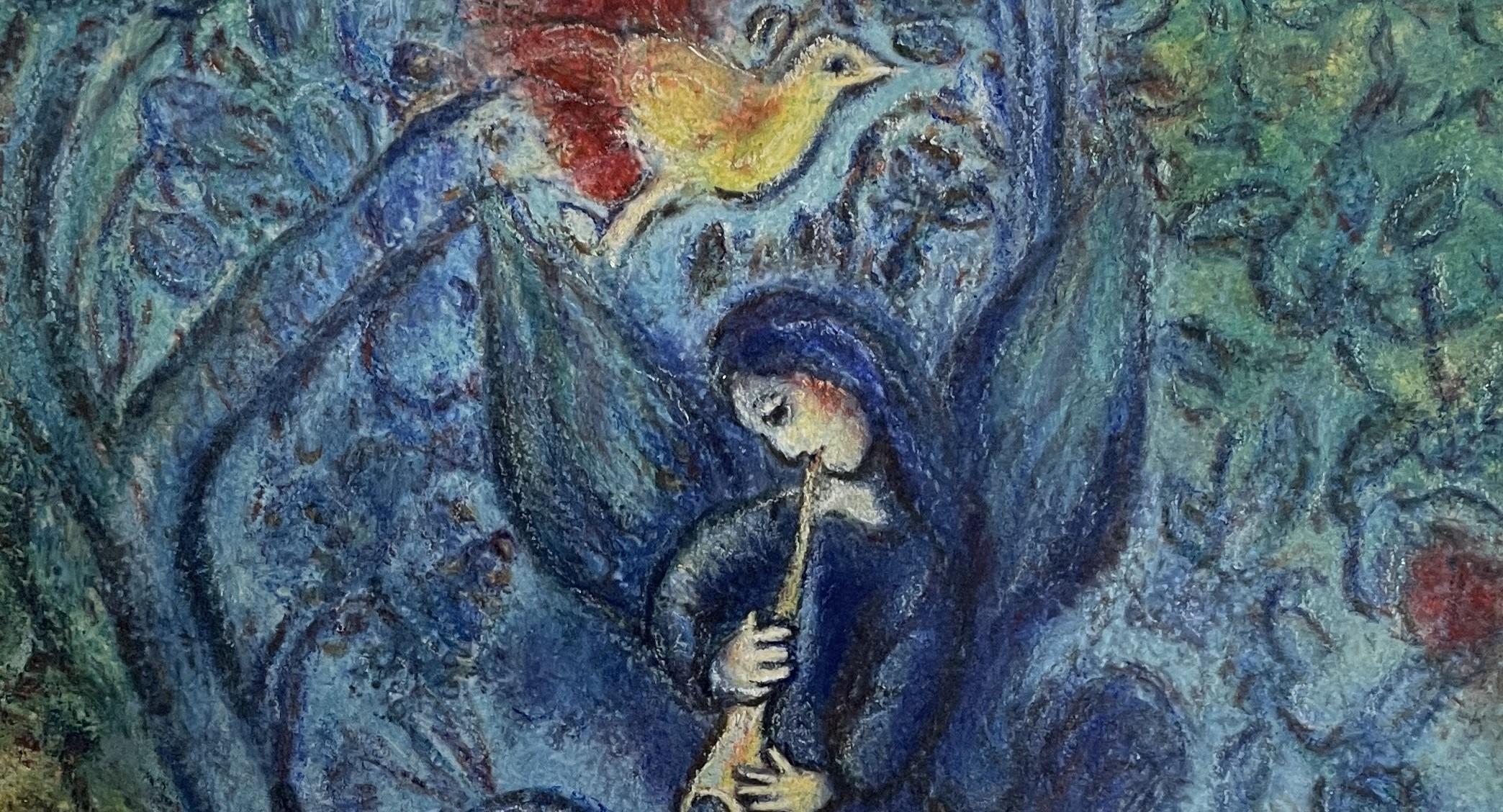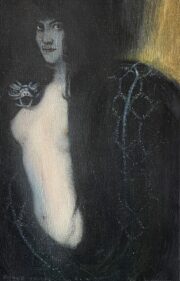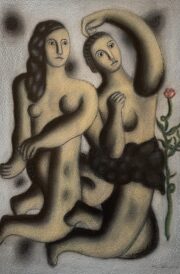日本語-Englishー台灣華語
フランツ・フォン・シュトゥック「罪」
シュトゥックは世紀末に「罪」でセンセーションを巻き起こし、一躍名を成したが、その後「罪」を上回る絵は生涯描けなかった。シュトゥックの絵の水準は総じて決して高くはないが、こと「罪」に関しては、構図といい、女の視線といい、忘れることができない。蛇の長い体と髪は一体となって女の裸身を覆い、その瞳は挑発と満足を合わせ持つ。女の肉感的な呪縛から男は逃れられない。大蛇を身に纏い挑発するようにこちらを見つめている「罪」は、女と蛇の不変的関係を暗示している。嫉妬深い蛇に導かれ、女は新たに愛を経験する度に、新たな境地を切り開く。
古代エジプトにおいて蛇は女神の象徴とされ、多くの文化圏において蛇は神聖な生き物とされてきた。古い皮を脱ぎ捨てて体を純化しながら生きる蛇は、永遠の命の象徴である。女と蛇は定期的に再生するという意味で共通するものがある。蛇は自らの皮を脱ぎ捨てて再生し、女は古くなった子宮の層を剥離することによって生理的にも新しい女に生まれ変わる。蛇は人間より先に大地に住んでいた知識と経験を有する生物であり、古代ギリシャでは知恵の象徴とされていた。キリスト教の世界では、イヴを誘惑して知恵の木の実を食べさせた蛇は、悪魔の使者とされているが、そこには知識を得ることによって同時に重荷を背負い込んだことが暗示されている。この世の摂理を知ってしまうことは、純真無垢な心を失うことをも意味している。女は一度知った誘惑の味から逃れることはできない。この絵はそう語っている。極めて耽美主義的な画風で描かれた「罪」は、妖しい女性の魅力に身を滅ぼしてみたいという男の願望を表しているのかもしれない。
シュトゥックは象徴的な表現ではクノップフから強い影響を受けているが、繊細で夢想的なクノップフとは対極である。サロメやスフィンクスといった象徴派定番のテーマを描いているが、そこには何かが欠けている。シュトゥックの絵画には独特の明るさと現実感が満ちているのが災いしているのかもしれない。深い洞察の影がなく、気難しくなく、ほほえましくさえある。バイエルンの粉屋の息子であるシュトゥックは、風貌も親方風である。レジェのように素朴である。絵画の力量は今一つでも、親分肌の性格によって彼は生前成功を収め、ミュンヘン分離派の大立者になる。美術指導者としてキルヒナーやクレーを指導している。あのカンディンスキーでさえ一旦は彼の門をたたく。邸宅シュトゥック・ヴィラは今もユーゲントシュティール美術館として往時の栄華をとどめているが、さしもの絵画王も本人の人間的魅力を感じることができない死後には、絵画本来が持つ力量相応の評価に収束してしまう。画家の仕合せとは何だろうか。シュトゥックは世紀末の雰囲気に密着した世俗的な絵画を描き大衆的人気を得て成功を収めるが、その絵画は時代とともに滅びてしまう。それでもシュトゥックは「罪」を残したと言うべきではあるが。
Sin (Die Suende)
Stuck created a sensation with “Sin” at the turn of the century, becoming famous overnight, but he never managed to surpass “Sin” throughout his life. While Stuck’s overall level of painting is not particularly high, “Sin” is unforgettable for its composition and the woman’s gaze. The long body of the snake intertwining with the woman’s naked body, and her eyes that combine provocation and satisfaction, suggest that men cannot escape the sensual curse of women. “Sin,” with its depiction of a woman provocatively gazing out while draped in a large snake, hints at the unchanging relationship between women and snakes. Led by the jealous snake, each new experience of love opens new realms for the woman. In ancient Egypt, the snake was a symbol of the goddess, and in many cultures, snakes are considered sacred beings. Snakes, which shed their old skin to purify their bodies, symbolize eternal life. In this sense, women and snakes share the trait of periodic regeneration. Snakes shed their skin to rejuvenate, and women physiologically renew themselves by shedding the old layers of the uterus. In ancient Greece, the snake was a symbol of wisdom, living on the earth before humans, endowed with knowledge and experience. In Christianity, the snake that tempted Eve to eat the fruit of the Tree of Knowledge is seen as a messenger of the devil, implying that gaining knowledge also means taking on a burden. Knowing the ways of the world implies losing one’s innocence. Once a woman tastes temptation, she cannot escape it. This painting speaks to that message. “Sin,” depicted in an extremely decadent style, might express a man’s desire to be ruined by the allure of a mysterious woman.
Stuck was strongly influenced by Knopf in terms of symbolic expression, but he is the opposite of the delicate and dreamy Knopf. Although Stuck painted standard Symbolist themes like Salome and the Sphinx, something seems to be missing. His paintings suffer from a unique brightness and realism. Lacking deep insight, they are uncomplicated and even cheerful. Stuck, the son of a Bavarian miller, had a foreman-like appearance and was as straightforward as Léger. Despite his limited artistic talent, his genial nature helped him achieve success during his lifetime and become a prominent figure in the Munich Secession. He mentored artists like Kirchner and Klee. Even Kandinsky once sought his guidance. Today, his Stuck Villa still retains its former glory as a Jugendstil art museum, but even the so-called “king of paintings” converges to an evaluation appropriate to his artistic merit after death, unable to convey his personal charm. What is the happiness of a painter? Stuck achieved success and popular acclaim by painting secular works that resonated with the fin-de-siècle atmosphere, but his paintings faded with time. However, it should be said that Stuck left behind “Sin.”
弗朗茨·馮·施圖克《罪》
施圖克在世紀末期以《罪》引起轟動,一舉成名,但之後再也沒有畫出超越《罪》的作品。施圖克的畫作整體水平並不算高,但就《罪》而言,其構圖與女性視線都讓人難以忘懷。蛇的長身與髮絲融為一體,覆蓋女性的裸體,那雙眼睛兼具挑釁與滿足。男性無法逃脫女性的肉感魔力。身披巨蛇,挑釁地凝視這邊的《罪》,暗示了女性與蛇不變的關係。在嫉妒的蛇的引領下,每當女性體驗新的愛情,就會開闢新的境界。
在古埃及,蛇被視為女神的象徵,在許多文化中蛇都是被視為神聖的生物。脫去舊皮,通過身體的淨化而生活的蛇,是永恆生命的象徵。女性和蛇在定期重生的意義上有著共通之處。蛇藉由脫皮重生,女性則通過剝離舊的子宮層,在生理上成為全新的自我。蛇擁有比人類更早居住於大地上的知識和經驗,在古希臘被視為智慧的象徵。在基督教世界裡,誘使夏娃吃下智慧樹果實的蛇,被視為魔鬼的使者,這隱喻了獲取知識同時也意味著承擔重大的負擔。了解這世界的運行規則,也意味著失去純真無垢的心靈。女性一旦嚐到誘惑的滋味,便無法逃脫。這幅畫正是在說這個故事。以極致耽美主義的風格描繪的《罪》,可能在表達一種男性對於被神秘女性魅力所吞噬的願望。
施圖克在象徵主義表現上深受克諾普夫的影響,但與細膩夢幻的克諾普夫形成鮮明對比。他雖然繪製了諸如薩洛美或斯芬克斯等象徵派的經典主題,但似乎總缺少了某些東西。施圖克的畫作充滿了獨特的明亮感和現實感,這可能是其不足之處。缺乏深刻洞察的影子,不顯得難以接近,甚至帶有親切的笑容。作為巴伐利亞的一個磨坊主之子,施圖克的外表和風範也顯得領導有方。他的畫藝或許平平,但憑藉著他的領袖氣質,生前便取得了成功,成為慕尼黑分離派的重要人物。作為一名美術指導,他指導過基爾希納和克萊,甚至連康定斯基也曾敲過他的門。現在的施圖克別墅仍作為青年風格美術館保留著當年的輝煌,但即便是畫界的大師,死後也無法感受到個人魅力,其畫作的評價最終還是會回歸到作品本身的實際水平。畫家的幸福是什麼呢?施圖克雖然在世紀末的氛圍中繪製了接地氣的畫作,獲得了大眾的喜愛和成功,但那些畫作最終隨著時代而逝去。儘管如此,施圖克留下了《罪》這樣的作品,這是值得稱讚的。



